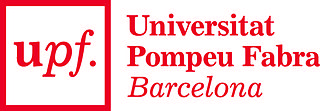
Pompeu Fabra University is a public university located in the city of Barcelona, Catalonia in Spain. The university was created by the Autonomous Government of Catalonia in 1990 and was named after Pompeu Fabra. UPF has been ranked the best university in Spain since 2015 and 16th best young university in the world in 2022 by the Times Higher Education World University Rankings.

Line 1, shortened to L1, coloured red and often simply called Línia vermella, is the second oldest Barcelona Metro line, after line L3. It is the longest line of the Barcelona Metro, and links L'Hospitalet de Llobregat and Santa Coloma de Gramenet. Originally operated by the independent Ferrocarril Metropolitano Transversal de Barcelona, it is today operated by Transports Metropolitans de Barcelona (TMB) and is part of the ATM fare-integrated main transport system. L1 is the only metro line in Spain to use Iberian gauge tracks, as used by most Spanish main line railways.
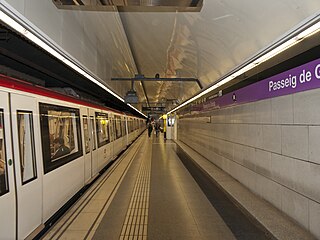
Line 2 is a metro line in Barcelona operated by TMB, coloured purple and sometimes called línia lila. It is part of the city's ATM fare-integrated transport network.

Estació de França is a major railway station in the city of Barcelona in Catalonia, Spain.

Fondo is a Barcelona Metro station in the municipality of Santa Coloma de Gramenet, in the northern part of the metropolitan area of Barcelona. It is served by two metro lines, L1, of which it is the northern terminus, and L9. It was built in 1992 under Camí Fondo de Badalona, in the neighbourhood of Fondo, between Carrer Dalmau and Carrer Verdi.

Paral·lel is a Barcelona metro station, located under Avinguda del Paral·lel, between the streets of Ronda de Sant Pau and Carrer Nou de la Rambla. It is served by L3, is the southern terminus of L2, and also the lower terminal of the Funicular de Montjuïc.
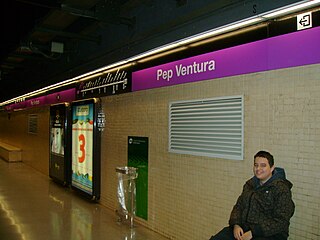
Pep Ventura is the name of a Barcelona metro station located in the municipality of Badalona, in the metropolitan area of Barcelona, and served by L2. It was the northern terminus of that line until 2010, when it was extended into the town centre and into the station Badalona Pompeu Fabra.

Ciutadella | Vila Olímpica is the name of a station in the Barcelona Metro network, as well of a nearby Trambesòs station in the Sant Martí district of Barcelona. It's named after one of Barcelona's major parks, Parc de la Ciutadella, and La Vila Olímpica del Poblenou, a neighbourhood in the immediate vicinities. It's served by L4, and tram route T4, of which it is a terminus. It was built in 1977 under Parc de Carles I. It was closed between 1991 and 1992 because of infrastructure improvement with the occasion of the 1992 Olympic Games, and again as of mid-2007 due to improvement of L4.
Line 13 is the name of a proposed service in the Barcelona Metro network which would join La Morera (neighborhood) in Badalona, a municipality of Barcelonès to the north of Barcelona, with the hilly area around Can Ruti Hospital. The line, which will be a short hybrid light rail-metro addition to the main subway lines which will cover a poorly communicated area, similar to L11 and L8, was announced in 2002 by Generalitat de Catalunya. It was also made public the line will be displayed in maps using a shade of pink.

The Barcelona Biomedical Research Park ("PRBB") is an agglomeration of six public research centres and is located alongside the Hospital del Mar de Barcelona. The PRBB is the product of an initiative launched by the Government of Catalonia, the City Council of Barcelona and the Pompeu Fabra University (UPF), which aims to promote research and collaboration between closely related fields. Each centre works independently in its own field and a management group, the PRBB Consortium, is responsible for managing the building and facilities, in addition to coordinating joint scientific research activities among the various centres. About 1,400 people are employed in the PRBB, making it one of the largest biomedical research clusters in the south of Europe. The centre was opened in May 2006.
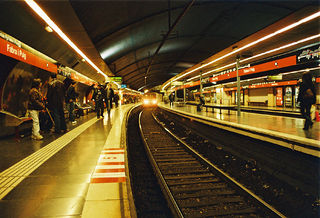
Fabra i Puig is a Barcelona Metro station, on L1, located in the Sant Andreu district of Barcelona, below Avinguda Meridiana between Carrer de Concepció Arenal i Passeig de Fabra i Puig. It opened in 1954, with the extension of the aforementioned line from Sagrera to this station. Passengers can commute here for the Renfe-operated Sant Andreu Arenal railway station. It's named after Passeig de Fabra i Puig, one of the main thoroughfares of the area.
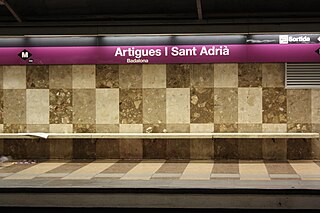
Artigues | Sant Adrià is a Barcelona Metro station in Badalona, named after the neighbourhood of the same name. Despite the latter part of the name, it is not in Sant Adrià del Besòs, and the tag Badalona was added to all signage in the station to avoid confusion. It is served by L2. It opened in 1985 with the name Joan XXIII as part of L4 and became a L2 station in 2002. It can be accessed from Carretera de Santa Coloma and from Avinguda de Joan XXIII.

Sant Roc is a Barcelona Metro station in Sant Roc, a neighbourhood of the municipality of Badalona, in the metropolitan area of Barcelona. It's served by L2 and since 2007, by Trambesòs route T5. It was opened in 1985 as part of L4 and moved to L2 in 2002. It can be accessed from Plaça President Tarradellas and from Carrer Alfons XII.
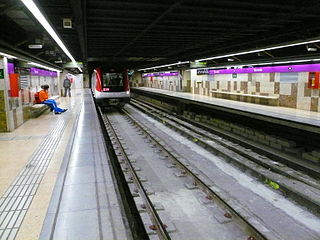
Verneda is a Barcelona Metro station in the Verneda neighbourhood of Sant Adrià de Besòs, a suburb of Barcelona. It's served by L2. It was opened in 1985, although it was part of L4 back then, until a major change in both lines took place in 2002 to ease transportation from Badalona to Barcelona. The platforms are 93 m. long.

La Vila Olímpica del Poblenou or La Villa Olímpica is a neighborhood in the Sant Martí district of Barcelona, Catalonia (Spain). It was constructed in the late 1980s and early 1990s for the 1992 Summer Olympic Games which took place in Barcelona. Its construction was devised by Oriol Bohigas, David Mackay, and Albert Puigdomènec as a residential area in the otherwise industrial and working-class district of Poblenou, which underwent regeneration but involved massive expropriation, as well as the destruction of a sizeable portion of the district, including Industrial Revolution factories of architectural value such as Fàbrica Foret. It follows essentially the reticular outline of Eixample and Poblenou, with about 2000 new apartments in the area, owned by the mixed public-private company VOSA.
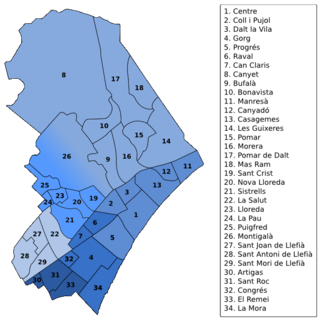
Centre is the usual name for the central area of Badalona, a locality in the metropolitan area of Barcelona. It is located in the District 1 by the Mediterranean Sea, and is a commercial and residential area with good transportation connections. It had 1344 inhabitants in the 2010 census.

Artigues is an area of Badalona neighbouring Sant Adrià de Besòs. The name derives from a real estate promoter and publisher, Francesc Artigas i Solà, who urbanised the area in 1912. The two spellings of the name reflect Catalan orthography before and after Pompeu Fabra's reform. It was also known as Colònia Artigas, following the convention used in similar industrial areas in the province of Barcelona, and even though officially in the municipality of Badalona, it was often considered to be very autonomous from it and closer to Sant Adrià de Besòs. Within Badalona, it's one of the neighbourhoods which make up the town's district 6. It's part of the innermost region of the metropolitan area of Barcelona, not far from Barcelona proper. Its administrative borders are four streets: carrer d'Alfons XIII, carrer de Bogatell, carrer de Covadonga and carrer de l'Onze de Setembre. The immigrant population of Artigues is important, and during political campaign, some political parties have used their stance on migration policies and management in Artigues as part of their discourse.

El Progrés is a coastal area of Badalona in the town's District 1, and as such, part of the metropolitan area of Barcelona. It is bordered by Gorg, La Mora, Raval, Can Claris, Centre and the Mediterranean Sea. As of the 2012 census El Progrés had 11,059 inhabitants, or 5% of Badalona's population. Like many toponyms in the town the name of this neighbourhood —which is Catalan for "The Progress"— evokes the industrial age which was the time of its inception.


















